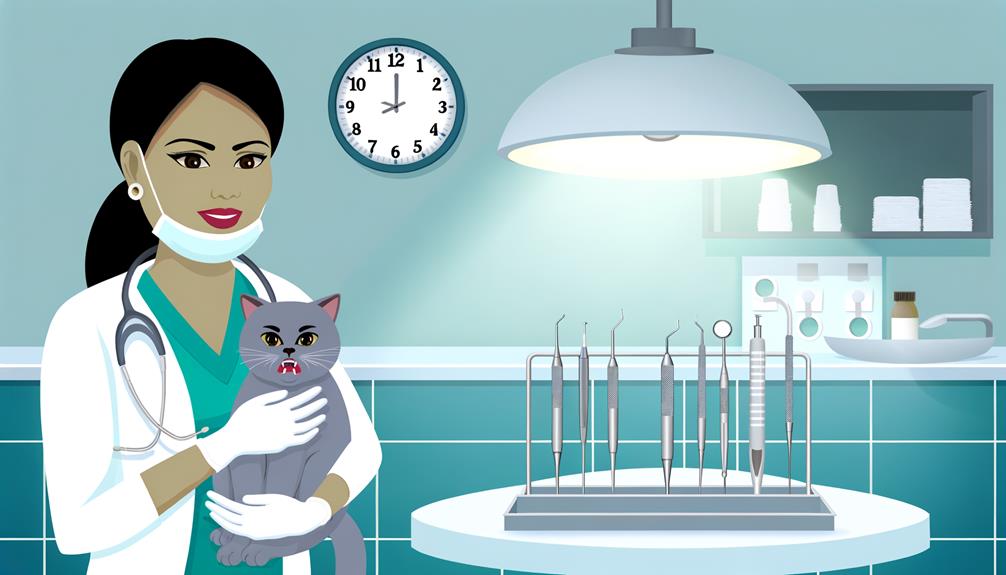When you're taking your cat in for a dental cleaning, you might wonder just how long the process will take. Typically, it ranges from 1 to 2 hours, but several factors influence this timing. The procedure isn't just about cleaning; it involves anesthesia, radiographic evaluations, and careful monitoring. Each step guarantees your cat's safety and the thoroughness of the cleaning. But what exactly happens during those hours, and why does it vary so much? Understanding these details can help you better prepare for your cat's appointment and know what to expect.
Preparing for the Dental Appointment
Preparing for a cat's dental appointment involves several important steps to guarantee a safe and effective procedure. First, preoperative lab work is significant. Your veterinarian will likely recommend blood tests to assess organ function, electrolyte balance, and overall health status. This confirms your cat is a suitable candidate for anesthesia, essential for anesthesia safety during the dental cleaning.
It's also important to withhold food from your cat on the morning of the procedure. This minimizes the risk of aspiration and other complications during anesthesia. Typically, you should stop feeding your cat after midnight before the appointment, but water is usually allowed until a few hours before. Always follow your veterinarian's specific instructions.
Discussing any necessary pre-procedure medications with your veterinarian is another key step. Some cats may require antibiotics or other medications to manage underlying health conditions or to prevent infection. Your veterinarian will tailor these recommendations to your cat's individual needs, confirming a smoother procedure.
Confirming your cat's health status with your veterinarian is important. During the preoperative evaluation, the veterinarian will conduct an oral exam to identify any existing dental issues. This thorough assessment helps in planning the dental cleaning procedure, determining if extractions or other interventions are needed.
Adequate preparation confirms that your cat is in ideal health prior to undergoing dental work. By following these steps, you can help facilitate a successful and safe dental cleaning for your feline companion. Remember, collaborating closely with your veterinarian throughout this process is crucial for the best outcomes.
Importance of Anesthesia
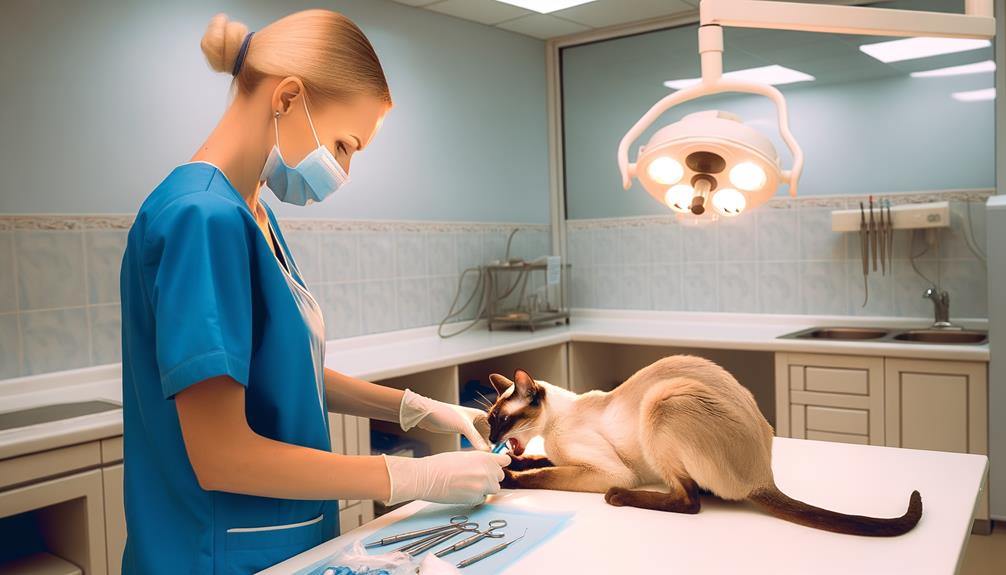
Understanding the importance of anesthesia in a cat dental cleaning is essential for ensuring a thorough and safe procedure. Anesthesia plays a vital role in facilitating a detailed assessment and treatment of your cat's dental health. Without it, fully evaluating each tooth and addressing any underlying issues would be nearly impossible.
Here are key reasons why anesthesia is indispensable during a cat dental cleaning:
- Thorough Evaluation: Anesthesia allows veterinarians to perform a meticulous examination of each tooth, ensuring any dental problems can be accurately identified and treated.
- Full Mouth X-Rays: To detect hidden dental issues such as root abscesses or bone loss, full mouth x-rays are necessary, which can only be safely conducted under anesthesia.
- Airway Protection: During the dental procedure, anesthesia helps maintain a secure airway, preventing water or debris from entering the lungs, which is essential for a safe cleaning process.
- Pain Management: Procedures like extractions, which can be painful, are performed safely under anesthesia, ensuring your cat experiences minimal discomfort.
- Stress Reduction: Anesthesia considerably reduces stress and discomfort for your cat, making the dental cleaning a more humane and effective process.
Monitoring During the Procedure
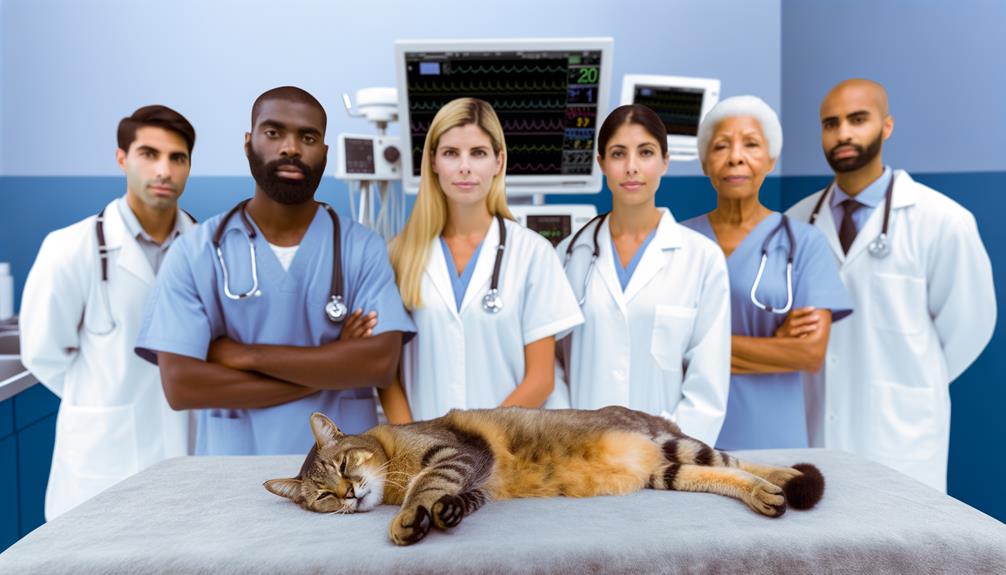
During the dental cleaning procedure, a dedicated veterinary technician will continuously monitor your cat's essential signs to guarantee ideal safety. Advanced monitors assess heart rate, respiratory rate, oxygenation levels, and EKG readings, while temperature is closely tracked to prevent hypothermia or overheating. Immediate response protocols are in place to address any sudden changes in your cat's condition, assuring a high standard of care throughout the anesthesia period.
Continuous Vital Signs Monitoring
Guaranteeing a cat's safety during a dental cleaning procedure hinges on continuous essential signs monitoring. Dedicated veterinary technicians are tasked with continuously monitoring the cat's critical signs, which include heart rate, respiratory rate, and oxygenation, throughout the anesthesia phase. This process is imperative for maintaining patient safety during dental cleanings.
- Heart Rate: Monitored via EKG to detect any arrhythmias or abnormal rhythms.
- Respiratory Rate: Assessed to ascertain the cat is breathing adequately under anesthesia.
- Oxygenation: Measured with pulse oximetry to verify sufficient oxygen supply.
- Temperature: Monitored to prevent hypothermia, which is common during anesthesia.
- Blood Pressure: Checked to maintain stable cardiovascular function.
Utilizing multiple advanced monitoring devices, such as EKGs and temperature monitors, allows the veterinary team to provide real-time assessments of the cat's condition. Continuous monitoring offers the ability to react instantly to any changes in critical signs, greatly enhancing patient safety. This vigilance is especially essential during potentially painful procedures and anesthesia, guaranteeing the cat remains stable and comfortable. Employing such rigorous monitoring protocols not only provides peace of mind for the veterinary team and pet owners but also affirms the highest standard of care during dental cleanings.
Immediate Response Protocols
Maintaining continuous monitoring of a cat's essential signs is a cornerstone of safety during dental cleanings. A dedicated veterinary technician is always present, vigilantly tracking the cat's critical signs. These include heart rate, respiratory rate, and oxygenation, which are essential indicators of the cat's well-being under anesthesia.
The use of multiple monitors provides real-time data, guaranteeing that any deviations from normal values are immediately identified. An EKG, for instance, allows for precise monitoring of the heart's electrical activity, while consistent temperature checks help in maintaining an ideal body temperature throughout the procedure. These detailed observations make it possible to react swiftly to any anomalies, thereby enhancing the overall safety of the cat.
Immediate response protocols are meticulously followed to address any changes in the cat's condition. This means that if there's an unexpected drop in heart rate or oxygenation levels, the veterinary team is equipped to take prompt corrective measures. These protocols are designed not just for safety but also to give you peace of mind, knowing your cat is under constant, expert observation. Consequently, continuous monitoring and immediate response protocols work hand-in-hand to guarantee the highest standard of care during your cat's dental cleaning.
Radiographs and Dental Evaluation
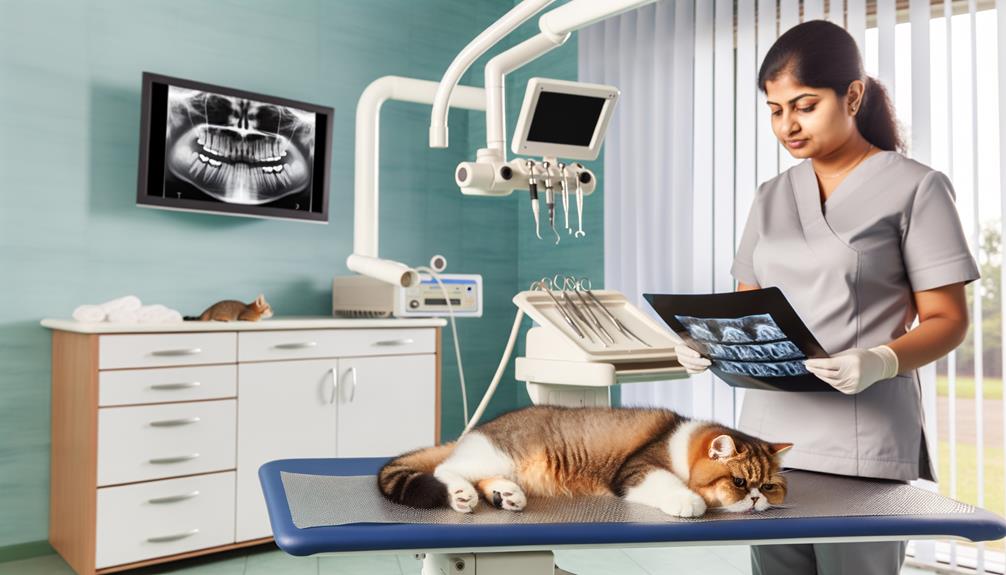
A thorough dental evaluation for your cat includes full mouth x-rays, an indispensable tool in veterinary dentistry. Radiographs, or dental x-rays, play a significant role in providing a thorough assessment of your cat's dental health. These x-rays reveal hidden issues beneath the gums that aren't visible during a simple visual examination. They help veterinarians evaluate the condition of the teeth, bone, and surrounding tissues, which is essential for diagnosing and treating periodontal disease and other dental problems.
During the dental cleaning process, radiographs provide a clear and detailed picture of your cat's oral health. This combined approach guarantees that no potential issue is overlooked and that your cat receives the best possible care. Here's why radiographs and dental evaluations are critical:
- Detection of Hidden Issues: X-rays can identify problems such as tooth resorption, unerupted teeth, and bone loss that aren't visible to the naked eye.
- Assessing Tooth Integrity: They help evaluate the structural integrity of each tooth, which is important for determining if any teeth need to be extracted.
- Evaluating Bone Health: The condition of the jawbone and other supporting structures can be assessed, confirming that periodontal disease is caught early.
- Guiding Treatment Plans: Detailed radiographic evaluations are fundamental for planning necessary treatments, including extractions and advanced dental procedures.
- Monitoring Progress: Follow-up x-rays can track the effectiveness of treatments and monitor the progression of dental conditions over time.
Incorporating radiographs into a dental evaluation guarantees that your cat's dental health is thoroughly assessed and managed, providing them with the highest standard of veterinary care.
Post-Procedure Care

After a cat dental cleaning, you'll need to monitor your pet closely for any adverse reactions to anesthesia, such as lethargy or reduced appetite. Pain management is essential, especially if extractions were performed; veterinarians typically administer analgesics to guarantee your cat's comfort. Providing a soft diet and adhering to follow-up care instructions will support ideal recovery.
Monitoring Post-Anesthesia
Following a cat dental cleaning, vigilant post-anesthesia monitoring is crucial for guaranteeing a safe recovery. Veterinary technicians will keep a close watch on your cat to track critical essential signs, guaranteeing any complications from anesthesia are promptly addressed. The primary focus during this period is to observe the cat's heart rate, respiratory rate, oxygenation levels, EKG, and body temperature. These parameters help detect any adverse reactions early, allowing for immediate intervention.
Post-anesthesia recovery generally takes place in a controlled environment within the veterinary facility. This setting allows for close observation until your cat is stable and alert enough to go home. During this time, your veterinary team will guarantee that your pet regains normal physiological function and shows no signs of distress or abnormality.
Here are some key points to take into account:
- Continuous monitoring: Dedicated technicians observe essential signs to detect changes.
- Controlled environment: Guarantees immediate intervention if needed.
- Stabilization: Cats are observed until they are alert and stable.
- Follow-up care: Instructions provided for home care post-procedure.
- Essential signs: Heart rate, respiratory rate, oxygenation, EKG, and temperature are closely watched.
This thorough monitoring process is fundamental for a smooth and safe recovery following dental procedures.
Pain Management Strategies
Effective pain management strategies are essential to guarantee your cat's comfort and expedite recovery post-dental procedure. Pain medication is routinely administered to all cats undergoing extractions, making sure they remain comfortable during the recovery phase. Initially, injectable pain relief is given immediately after the procedure, providing a seamless shift to at-home care.
Tailoring pain management to your cat's specific needs is critical. Factors such as their overall health status and the complexity of the dental care they received will determine the precise approach. Your veterinarian will prescribe appropriate pain medication based on these individual assessments.
Follow-up care is equally important. Regular monitoring helps identify and address any lingering pain or discomfort. You'll need to observe your cat closely, noting any signs of distress or changes in behavior that could indicate ongoing pain. Promptly communicating these observations to your vet can guarantee timely adjustments to their pain management plan.
A soft diet is recommended post-extraction, as it minimizes discomfort while eating and supports the healing process. Switching to softer foods or moistened kibble can alleviate stress on your cat's gums and teeth, fostering a smoother recovery.
Variability Among Veterinary Practices
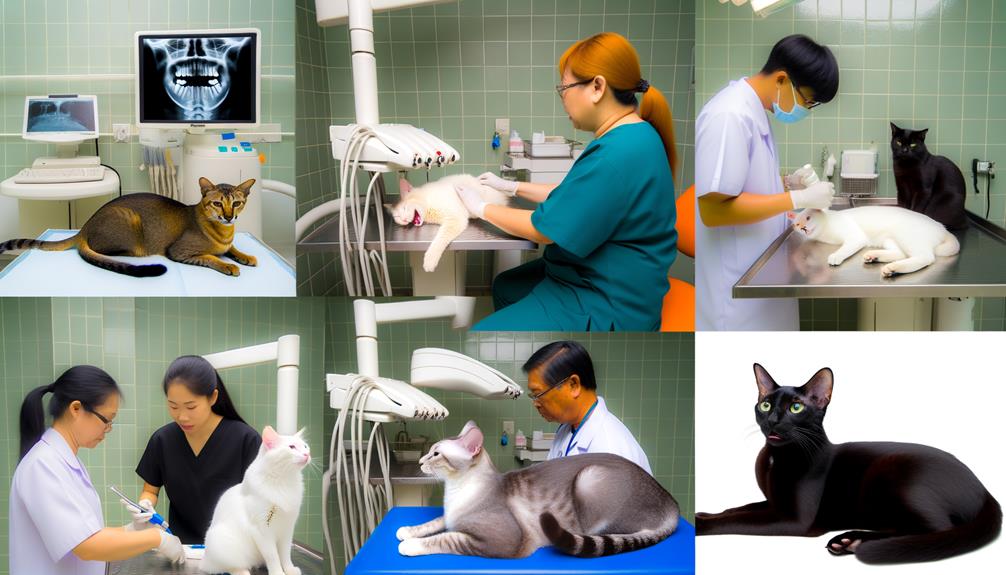
Different veterinary practices can vary considerably in their approach to cat dental cleanings, which can impact the total time required for the procedure. When scheduling your cat dental appointment, understanding these variations can help you set realistic expectations.
To begin with, some clinics specialize exclusively in dental procedures, which can streamline the process and reduce appointment times. These specialized practices often have efficient workflows, allowing them to address dental disease in pets' teeth more quickly. However, this isn't the case for all veterinary practices.
Here are some key factors that contribute to variability among veterinary practices:
- Anesthesia Methods: Different practices may use varying anesthesia protocols. Clinics that use full anesthesia may have longer recovery periods compared to those using alternative methods.
- Advanced Treatments: Availability of advanced dental treatments, such as root canals or extractions, can extend the length of your cat's appointment compared to a basic cleaning.
- Clinic Workload: The clinic's daily schedule and the number of patients they see can greatly affect appointment length. Busy practices may experience delays.
- Specialized Equipment and Staff: Clinics equipped with state-of-the-art dental tools and trained staff can often perform procedures more efficiently.
- Pre- and Post-Procedure Care: Some clinics may have more thorough pre-procedure assessments and post-procedure care routines, adding to the overall time.
The duration of a cat dental appointment can, thus, be influenced by the clinic's specific protocols and resources. Opting for a practice that aligns with your needs and understanding these factors can help promote a smoother experience for both you and your furry friend.
